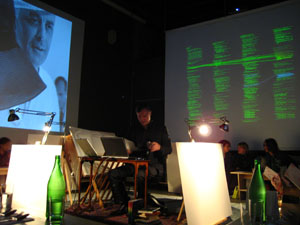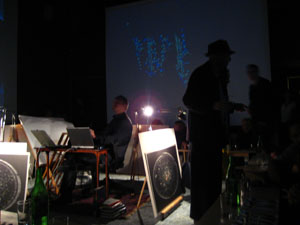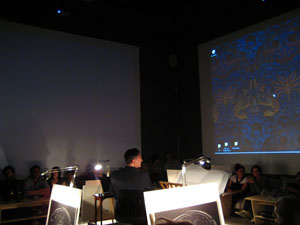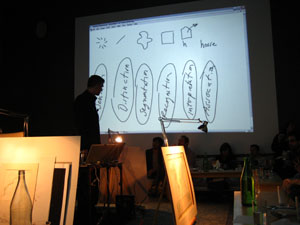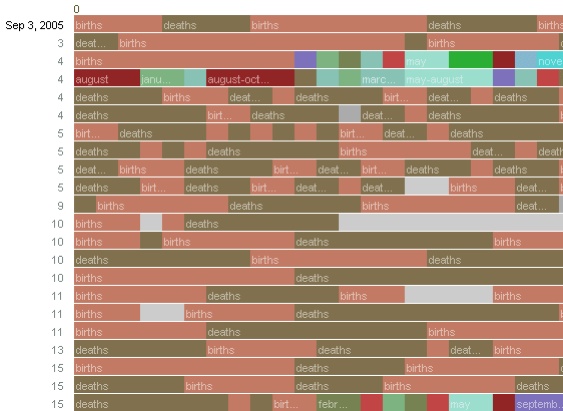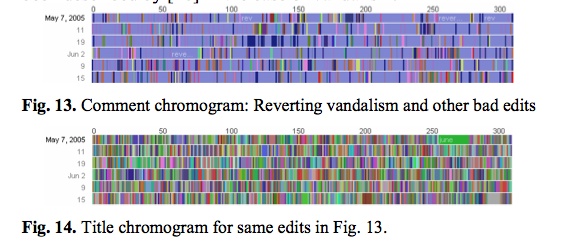Two weeks ago, when the blog-based peer review of Noah Wardrip-Fruin’s Expressive Processing began on Grand Text Auto, Bob sent a note about the project to Don Waters, the program officer for scholarly communications at the Andrew W. Mellon Foundation -? someone very much at the forefront of developments in the digital publishing arena. He wrote back intrigued but slightly puzzled as to the goals, scope and definitions of the experiment. We forwarded the note to Noah and to Doug Sery, Noah’s editor at MIT Press, and decided each to write some clarifying responses from our different perspectives: book author/blogger (Noah), book editor (Doug), and web editor (myself). The result is an interesting exchange about networked publishing and useful meta-document about the project. As our various responses, and Don’s subsequent reply, help to articulate, playing with new forms of peer review is only one aspect of this experiment, and maybe not even the most interesting one. The exchange is reproduced below (a couple of names mentioned have been made anonymous).
Don Waters (Mellon Foundation):
Thanks, Bob. This is a very interesting idea. In reading through the materials, however, I did not really understand how, if at all, this “experiment” would affect MIT Press behavior. What are the hypotheses being tested in that regard? I can see, from one perspective, that this “experiment” would result purely in more work for everyone. The author would get the benefit of the “crowd” commenting on his work, and revise accordingly, and then the Press would still send the final product out for peer review and copy editing prior to final publication.
Don
Ben Vershbow (Institute for the Future of the Book):
There are a number of things we set out to learn here. First, can an open, Web-based review process make a book better? Given the inherently inter-disciplinary nature of Noah’s book, and the diversity of the Grand Text Auto readership, it seems fairly likely that exposing the manuscript to a broader range of critical first-responders will bring new things to light and help Noah to hone his argument. As can be seen in his recap of discussions around the first chapter, there have already been a number of incisive critiques that will almost certainly impact subsequent revisions.
Second, how can we use available web technologies to build community around a book, or to bring existing communities into a book’s orbit? “Books are social vectors, but publishers have been slow to see it,” writes Ursula K. Le Guin in a provocative essay in the latest issue of Harper’s. For the past three years, the Institute for the Future of the Book’s mission has been to push beyond the comfort zone of traditional publishers, exploring the potential of networked technologies to enlarge the social dimensions of books. By building a highly interactive Web component to a text, where the author and his closest peers are present and actively engaged, and where the entire text is accessible with mechanisms for feedback and discussion, we believe the book will occupy a more lively and relevant place in the intellectual ecology of the Internet and probably do better overall in the offline arena as well.
The print book may have some life left in it yet, but it now functions within a larger networked commons. To deny this could prove fatal for publishers in the long run. Print books today need dynamic windows into the Web and publishers need to start experimenting with the different forms those windows could take or else retreat further into marginality. Having direct contact with the author -? being part of the making of the book -? is a compelling prospect for the book’s core audience and their enthusiasm is likely to spread. Certainly, it’s too early to make a definitive assessment about the efficacy of this Web outreach strategy, but initial indicators are very positive. Looked at one way, it certainly does create more work for everyone, but this is work that has to be done. At the bare minimum, we are building marketing networks and generating general excitement about the book. Already, the book has received a great deal of attention around the blogosphere, not just because of its novelty as a publishing experiment, but out of genuine interest in the subject matter and author. I would say that this is effort well spent.
It’s important to note that, despite CHE’s lovely but slightly sensational coverage of this experiment as a kind of mortal combat between traditional blind peer review and the new blog-based approach, we view the two review processes as complementary, not competitive. At the end, we plan to compare the different sorts of feedback the two processes generate. Our instinct is that it will suggest hybrid models rather than a wholesale replacement of one system with another.
That being said, our instincts tell us that open blog-based review (or other related forms) will become increasingly common practice among the next generation of academic writers in the humanities. The question for publishers is how best to engage with, and ideally incorporate, these new practices. Already, we see a thriving culture of pre-publication peer review in the sciences, and major publishers such as Nature are beginning to build robust online community infrastructures so as to host these kinds of interactions within their own virtual walls. Humanities publishers should be thinking along the same lines, and partnerships with respected blogging communities like GTxA are a good way to start experimenting. In a way, the MIT-GTxA collab represents an interface not just of two ideas of peer review but between two kinds of publishing imprints. Both have built a trusted name and become known for a particular editorial vision in their respective (and overlapping) communities. Each excels in a different sort of publishing, one print-based, the other online community-based. Together they are greater than the sum of their parts and suggest a new idea of publishing that treats books as extended processes rather than products. MIT may regard this as an interesting but not terribly significant side project for now, but it could end up having a greater impact on the press (and hopefully on other presses) than they expect.
All the best,
Ben
Noah Wardrip-Fruin (author, UC San Diego):
Hi Bob –
Yesterday I went to meet some people at a game company. There’s a lot of expertise there – and actually quite a bit of reflection on what they’re doing, how to think about it, and so on. But they don’t participate in academic peer review. They don’t even read academic books. But they do read blogs, and sometimes comment on them, and I was pleased to hear that there are some Grand Text Auto readers there.
If they comment on the Expressive Processing manuscript, it will create more work for me in one sense. I’ll have to think about what they say, perhaps respond, and perhaps have to revise my text. But, from my perspective, this work is far outweighed by the potential benefits: making a better book, deepening my thinking, and broadening the group that feels academic writing and publishing is potentially relevant to them.
What makes this an experiment, from my point of view, is the opportunity to also compare what I learn from the blog-based peer review to what I learn from the traditional peer review. However, this will only be one data point. We’ll need to do a number of these, all using blogs that are already read by the audience we hope will participate in the peer review. When we have enough data points perhaps we’ll start to be able to answer some interesting questions. For example, is this form of review more useful in some cases than others? Is the feedback from the two types of review generally overlapping or divergent? Hopefully we’ll learn some lessons that presses like MITP can put into practice – suggesting blog-based review when it is most appropriate, for example. With those lessons learned, it will be time to design the next experiment.
Best,
Noah
Doug Sery (MIT Press):
Hi Bob,
I know Don’s work in digital libraries and preservation, so I’m not surprised at the questions. While I don’t know the breadth of the discussions Noah and Ben had around this project, I do know that Noah and I approached this in a very casual manner. Noah has expressed his interest in “open communication” any number of times and when he mentioned that he’d like to “crowd-source” “Expressive Processing” on Grand Text Auto I agreed to it with little hesitation, so I’m not sure I’d call it an experiment. There are no metrics in place to determine whether this will affect sales or produce a better book. I don’t see this affecting the way The MIT Press will approach his book or publishing in general, at least for the time being.
This is not competing with the traditional academic press peer-review, although the CHE article would lead the reader to believe otherwise (Jeff obviously knows how to generate interest in a topic, which is fine, but even a games studies scholar, in a conversation I had with him today, laughingly called the headline “tabloidesque.”) . While Noah is posting chapters on his blog, I’m having the first draft peer-reviewed. After the peer-reviews come in, Noah and I will sit down to discuss them to see if any revisions to the manuscript need to be made. I don’t plan on going over the GTxA comments with Noah, unless I happen to see something that piques my interest, so I don’t see any additional work having to be done on the part of MITP. It’s a nice way for Noah to engage with the potential audience for his ideas, which I think is his primary goal for all of this. So, I’m thinking of this more as an exercise to see what kind of interest people have in these new tools and/or mechanisms. Hopefully, it will be a learning experience that MITP can use as we explore new models of publishing.
Hope this helps and that all’s well.
Best,
Doug
Don Waters:
Thanks, Bob (and friends) for this helpful and informative feedback.
As I understand the explanations, there is a sense in which the experiment is not aimed at “peer review” at all in the sense that peer review assesses the qualities of a work to help the publisher determine whether or not to publish it. What the exposure of the work-in-progress to the community does, besides the extremely useful community-building activity, is provide a mechanism for a function that is now all but lost in scholarly publishing, namely “developmental editing.” It is a side benefit of current peer review practice that an author gets some feedback on the work that might improve it, but what really helps an author is close, careful reading by friends who offer substantive criticism and editorial comments. Most accomplished authors seek out such feedback in a variety of informal ways, such as sending out manuscripts in various stages of completion to their colleagues and friends. The software that facilitates annotation and the use of the network, as demonstrated in this experiment, promise to extend this informal practice to authors more generally. I may have the distinction between peer review and developmental editing wrong, or you all may view the distinction as mere quibbling, but I think it helps explain why CHE got it so wrong in reporting the experiment as struggle between peer review and the blog-based approach. Two very different functions are being served, and as you all point out, these are complementary rather than competing functions.
I am very intrigued by the suggestions that scholarly presses need to engage in this approach more generally, and am eagerly learning from this and related experiments, such as those at Nature and elsewhere, more about the potential benefits of this kind of approach.
Great work and many thanks for the wonderful (and kind) responses.
Best,
Don

